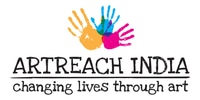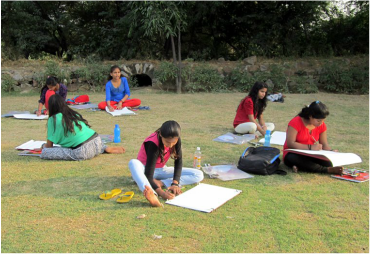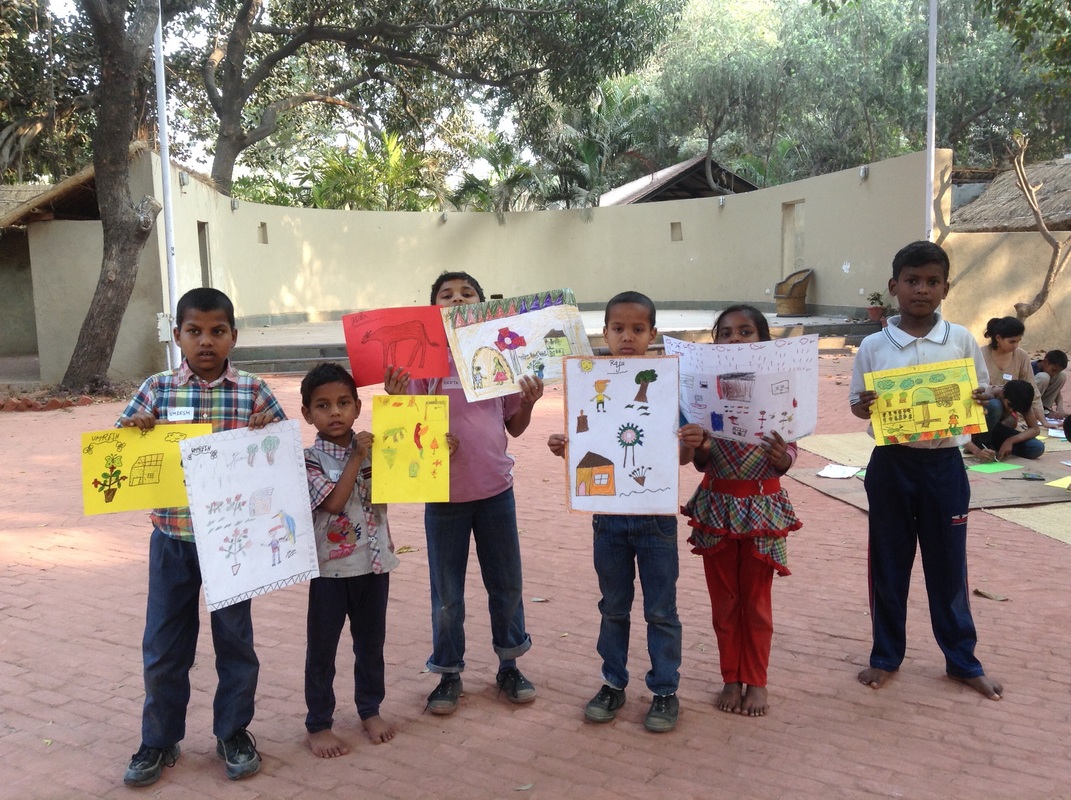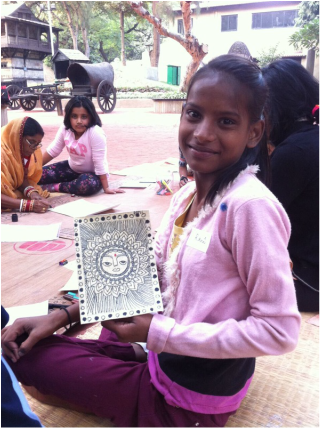Active Participants to date
Volunteer Residencies
|
Khel Mel
|
Community Arts
|
Teaching Fellowship
|
Since our first project in 2010, Artreach India has arranged volunteer residencies for twenty-seven artists from India and abroad. We have given grants to a further four artists -- our teaching fellows and community arts grantees. Through our Khel Mel workshops we have worked with eight master craftspeople. We have partnered with twelve NGOs and institutions, to reach six hundred children and young people who have participated in our programmes, with more than a thousand children and adults benefitting from our work.
Since our first project in 2010, Artreach India has arranged volunteer residencies for twenty-seven artists from India and abroad. We have given grants to a further four artists -- our teaching fellows and community arts grantees. Through our Khel Mel workshops we have worked with eight master craftspeople. We have partnered with twelve NGOs and institutions, to reach six hundred children and young people who have participated in our programmes, with more than a thousand children and adults benefitting from our work.
Our Volunteer Residencies may be short-term collaborations, but we believe they have a long-term impact. The intense surge of creativity, the thinking outside of the box, the fun, the colour, all offer the children new exciting opportunities and in many cases a transformative experience.
Your presence gave our children a sea of opportunities to learn new things and look at things differently. You have inspired them to do things in their own ways. Nothing could have been better than this.
Rashmi Singh
Home Leader, Kilkari Home
Home Leader, Kilkari Home
The children immensely enjoyed working on the mural paintings and are very proud of their work. This hands-on experience also helped in teaching children about life skills such as teamwork, the power of imagination, discipline, creativity, enthusiasm for learning new things, and some recognized their hidden talents.
Poonam Sharma
Executive Council Member, Salaam Baalak Trust
Executive Council Member, Salaam Baalak Trust
And of course at the end of the residency the children get to live with their creations.
Like all of the kids, Hemant had only previously done art on paper, ‘I liked very much having the chance to paint on the walls and decorate my own space,’ he said. Chota Raju agreed. He loves ‘looking at my work every day’ and would like to learn more. Sonu Pradip was very excited about the project from the beginning, but he imagined something much smaller scale, ‘just one wall’. He was happy to see so many walls involved, ‘even outside, so in the winter when we sit, we can feel our work.
First City, March 2011
During our residencies we met children who wanted to develop their creative skills further. Deepak's talent and passion were noticed by Artreach artists and thanks to them he was given the chance to pursue his dreams of becoming an artist. From the Karm Marg home in Faridabad he moved on to study fine art at the International Institute of Fine Arts in Modinagar -- where according to his teachers he is one of his year's most talented students.
(To read about the Karm Marg mural and Deepak's dreams, please see the Artreach Archive.)
To offer more children like Deepak opportunities to explore and develop their talents, Artreach has launched an eight-month Teaching Fellowship. Through a sustained long-term engagement with a teaching artist, we hope many more young people will be empowered to follow their dreams as artists or embark on careers as creative professionals.
(To read about the Karm Marg mural and Deepak's dreams, please see the Artreach Archive.)
To offer more children like Deepak opportunities to explore and develop their talents, Artreach has launched an eight-month Teaching Fellowship. Through a sustained long-term engagement with a teaching artist, we hope many more young people will be empowered to follow their dreams as artists or embark on careers as creative professionals.
Our 2015-16 Teaching Fellow was Anni Kumari. She worked with students from NGO Aman Biradari-Rainbow Homes. You can see images and read more about the fellowship here.
This process seemed more intense, involved and introspective than the room-painting. The benefits are hard to describe in a few words, because it seemed to me that reaching within themselves and fetching those ideas and that talent from inside gave them an anchor that could very well persist for the better part of their lives.
I don’t think it matters how many of these girls will choose art as a career, though it'd be great if they did. To me, what mattered was that attention was paid to their latent talent, possibly to nurture it further, but mostly to help them familiarise themselves with that shining, unique spot of talent they have. It’s never easy to 'tell' a child to see this bright shining spot, whereas to have them reveal it to themselves is priceless and long-lasting!
Also, most children from mainstream family backgrounds are used to appreciation and discovering and showcasing all that is best about them. It isn’t as straightforward with our kids. I think this gave them that chance - appreciation, attention, discovery and showcasing, all in one.
Mansi Chaturvedi Sharma,
Aman Biradari-Rainbow Homes
Vandana Kothari is Artreach India’s teaching fellow for 2016-17. The programme is underway with students from NGO Udayan Care, and we are very excited to have received funding from the Kiran Nadar Museum of Art.
This process seemed more intense, involved and introspective than the room-painting. The benefits are hard to describe in a few words, because it seemed to me that reaching within themselves and fetching those ideas and that talent from inside gave them an anchor that could very well persist for the better part of their lives.
I don’t think it matters how many of these girls will choose art as a career, though it'd be great if they did. To me, what mattered was that attention was paid to their latent talent, possibly to nurture it further, but mostly to help them familiarise themselves with that shining, unique spot of talent they have. It’s never easy to 'tell' a child to see this bright shining spot, whereas to have them reveal it to themselves is priceless and long-lasting!
Also, most children from mainstream family backgrounds are used to appreciation and discovering and showcasing all that is best about them. It isn’t as straightforward with our kids. I think this gave them that chance - appreciation, attention, discovery and showcasing, all in one.
Mansi Chaturvedi Sharma,
Aman Biradari-Rainbow Homes
Vandana Kothari is Artreach India’s teaching fellow for 2016-17. The programme is underway with students from NGO Udayan Care, and we are very excited to have received funding from the Kiran Nadar Museum of Art.
Our Khel Mel programme – bringing children from different backgrounds together to learn and make art in a fun and creative and neutral environment – is an attempt to chip away at the very deep social divisions persisting in our society. Gordon W. Allport’s ‘intergroup contact hypothesis’ suggests that under appropriate conditions (equal status, intergroup co-operation, common goals, and support by social and institutional authorities) interpersonal contact is one of the most effective ways to reduce prejudice and discrimination.






